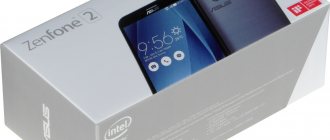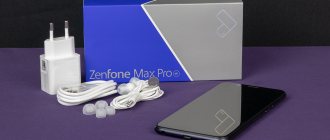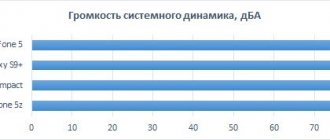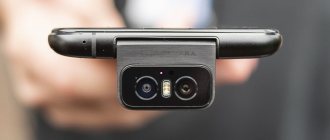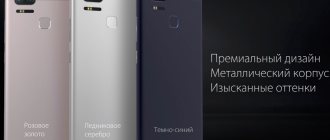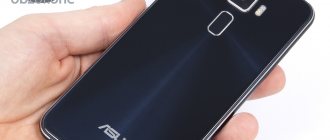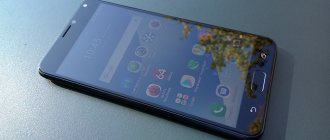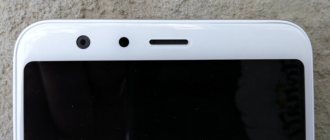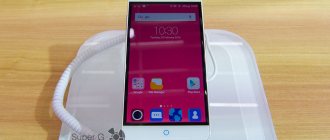ASUS did not rest on its laurels and, noticing that customers liked the idea of fighting with Xiaomi and Huawei on their field (discreet, but inexpensive smartphones with unexpectedly pleasant characteristics), decided to immediately build on the success. Meet ASUS Zenfone Max (M2) and Zenfone Max Pro (M2). This review is devoted primarily to the older (and more expensive) model, which, logically, received the word “Pro” in the name, but let’s say a few words about the “regular” Max.
Both new Zenfone are equipped with 6.26-inch screens with a cutout at the top, but while the Pro has Full HD+ resolution, the Max has HD. Also, the younger device has a weaker platform (Qualcomm Snapdragon 632 instead of Snapdragon 660), a simpler camera (also double, but 13+2 megapixels instead of 12+5) and a less capacious battery (4000 mAh instead of 5000 mAh), yes and its design is more modest - the back is lined not with glass, but with metal. But the price of ASUS Zenfone Max (M2) is 12,990 rubles versus 17,990 for Zenfone Max Pro (M2).
| ASUS Zenfone Max Pro (M2) and Zenfone Max (M2) side by side | ||
For this money, the older Zenfone Max Pro offers perhaps the most pleasant set of characteristics today, and in design it is as similar as possible to the older model, Zenfone 5. The values are the same as in the previous version (M1): a capacious battery, powerful for its price category hardware platform, normal camera and pure Android. The latter, in terms of talking about ASUS, which has been developing its Zen UI shell for many years, is especially surprising and pleasant.
Specifications
| ASUS Zenfone Max Pro (M2) | ASUS Zenfone Max (M2) | ASUS Zenfone Max Pro (M1) | Xiaomi Redmi Note 5 | Honor 8X | |
| Display | 6.26 inches, IPS, 2280 × 1080 pixels, 403 ppi; capacitive, multi-touch | 6.26 inches, IPS, 1520 × 720 pixels, 269 ppi; capacitive, multi-touch | 5.99 inches, IPS, 2160 × 1080 pixels, 403 ppi; capacitive, multi-touch | 5.99 inches, IPS, 2160 × 1080 pixels, 403 ppi; capacitive, multi-touch | 6.5 inches, IPS, 2340 × 1080 pixels, 396 ppi, capacitive multi-touch |
| Protective glass | Corning Gorilla Glass 6 | No information | No information | No information | No information |
| CPU | Qualcomm Snapdragon 660: eight Kryo 260 cores, 2.2 GHz | Qualcomm Snapdragon 632: eight Kryo 250 cores (8 × 1.8 GHz) | Qualcomm Snapdragon 636: eight Kryo 260 cores (8 × 1.8 GHz) | Qualcomm Snapdragon 636: eight Kryo 260 cores (8 × 1.8 GHz) | HiSilicon Kirin 710: eight cores (4 × Cortex A73 2.2 GHz + 4 × Cortex A53 1.7 GHz) |
| Graphics controller | Adreno 512, 850 MHz | Adreno 506, 650 MHz | Adreno 509, 720 MHz | Adreno 509, 720 MHz | ARM Mali-G51 MP4, 650 MHz |
| RAM | 4 GB | 3 GB | 3/4 GB | 3/4 GB | 4/6 GB |
| Flash memory | 64/128 GB | 32 GB | 32/64 GB | 32/64 GB + microSD | 64/128 GB |
| Connectors | MicroUSB, 3.5 mm | MicroUSB, 3.5 mm | MicroUSB, 3.5 mm | MicroUSB, 3.5 mm | MicroUSB, mini-jack 3.5 mm |
| Memory card slot | Yes (separate slot for microSD) | Yes (separate slot for microSD) | Eat | Eat | Yes (separate slot for microSD) |
| SIM cards | 2 × nano-SIM | 2 × nano-SIM | 2 × nano-SIM | 2 × nano-SIM | 2 × nano-SIM |
| Cellular connection 2G | GSM/GPRS/EDGE 850/900/1800/1900 MHz | GSM/GPRS/EDGE 850/900/1800/1900 MHz | GSM/GPRS/EDGE 850/900/1800/1900 MHz | GSM/GPRS/EDGE 850/900/1800/1900 MHz | GSM 850/900/1800/1900 MHz |
| Cellular 3G | UMTS 850/900/2100 MHz | UMTS 850/900/1900/2100 MHz | UMTS 850/900/1900/2100 MHz | UMTS 850/900/1900/2100 MHz | HSDPA 850/900/1900/2100 MHz |
| Cellular 4G | LTE Cat. 9 (450 Mbit/s), bands 1, 3, 5, 7, 8, 20, 40 | LTE Cat.4 (150 Mbit/s), bands 1, 3, 5, 7, 8, 20, 40 | LTE Cat. 13 (400 Mbit/s), bands 1, 3, 5, 7, 8, 20, 40 | LTE Cat. 12 (600/100 Mbit/s), bands 1, 3, 5, 7, 8, 34, 38, 39, 40, 41 | LTE Cat. 4 (150 Mbit/s), bands 1, 3, 7, 8, 34, 38, 39, 40, 41 |
| WiFi | 802.11 b/g/n; 2.4 GHz | 802.11 b/g/n; 2.4 GHz | 802.11 a/b/g/n; 2.4/5 GHz | 802.11 a/b/g/n/ac; 2.4/5 GHz | 802.11a/b/g/n/ac; 2.4/5 GHz |
| Bluetooth | 5.0 | 4.2 | 5.0 | 5.0 | 4.2 (aptX) |
| NFC | Eat | Eat | Eat | No | Eat |
| Navigation | GPS, A-GPS, GLONASS, BeiDou, Galileo, QZSS | GPS, A-GPS, GLONASS, BeiDou | GPS, A-GPS, GLONASS, BeiDou | GPS, A-GPS, GLONASS, BeiDou | GPS, A-GPS, GLONASS, BeiDou |
| Sensors | Illumination, proximity, accelerometer/gyroscope, magnetometer (digital compass) | Illumination, proximity, accelerometer/gyroscope, magnetometer (digital compass) | Illumination, proximity, accelerometer/gyroscope, magnetometer (digital compass) | Light, proximity, accelerometer/gyroscope, magnetometer (digital compass), IR sensor | Illumination, proximity, accelerometer/gyroscope, magnetometer (digital compass) |
| Fingerprint's scanner | Eat | Eat | Eat | Eat | Eat |
| Main camera | Dual module: 12 MP, ƒ/1.8 + 5 MP, phase detection autofocus, LED flash | Dual module: 13 MP, ƒ/1.8 + 2 MP, phase detection autofocus, LED flash | Dual module: 13 MP, ƒ/2.2 + 5 MP, phase detection autofocus, LED flash | Dual module: 12 MP, ƒ/1.9 + 5 MP, phase detection autofocus, dual LED flash | Dual module: 20 ƒ/1.8 + 2 MP, phase detection autofocus, LED flash |
| Front-camera | 13 MP, ƒ/2.0, no autofocus, no flash | 8 MP, ƒ/2.0, no autofocus, no flash | 8 MP, ƒ/2.2, no autofocus, no flash | 13 MP, without autofocus, with flash | 16 MP, ƒ/2.0, autofocus, no flash |
| Nutrition | Non-removable battery: 19 Wh (5000 mAh, 3.8 V) | Non-removable battery: 15.28 Wh (4000 mAh, 3.8 V) | Non-removable battery: 19 Wh (5000 mAh, 3.8 V) | Non-removable battery: 15.28 Wh (4000 mAh, 3.8 V) | Non-removable battery: 14.25 Wh (3750 mAh, 3.8 V) |
| Size | 157.9 × 75.5 × 8.5 mm | 158.4 × 76.3 × 7.7 mm | 159 × 76 × 8.45 mm | 158.6 × 75.4 × 8.05 mm | 160.4 × 76.6 × 7.8 mm |
| Weight | 175 g | 160 g | 180 g | 181 g | 175 g |
| Water and dust protection | No | No | No | No | No |
| operating system | Android 8.1 Oreo | Android 8.1 Oreo | Android 8.0 Oreo, ZenUI shell | Android 8.0 Oreo, MIUI shell | Android 8.1 Oreo, EMUI shell |
| Current price | 17,990 rubles for the 4/64 GB version, 19,990 rubles for the 4/128 GB version | 12,990 rubles for the 3/32 GB version | 13,300 rubles for the 32 GB version, 15,110 rubles for the 64 GB version, 17,700 rubles for the 128 GB version | 13,100 rubles for the 32 GB version, 15,490 rubles for the 64 GB version | 17,990 or 19,990 rubles depending on memory size |
| ASUS Zenfone Max Pro (M2) – information about the hardware according to the CPU-Z application | ||||
⇡#Design, ergonomics and software
ASUS Zenfone Max Pro (M2), unlike the version without the word “Pro” in the name, has noticeably changed in appearance compared to the first version - both on the front and back. On the front we see a fashionable screen stretched right up to the very corners of the body with a monobrow cutout in the center - it houses a light sensor, a status indicator and a front camera, and the earpiece goes right under the top edge.
The inexpensive gadget in Zenfone Max Pro (M2) is distinguished by relatively large frames around the screen. Despite the “eared” design, the Taiwanese were unable to completely get rid of them. The smartphone is quite large, as it should be for a device equipped with a 6.26-inch display. But all the dimensions and weight figures are quite comparable with those of competitors - despite the fact that the Zenfone Max Pro (M2) has a much more capacious battery.
ASUS Zenfone Max Pro (M2), front panel: in the cutout at the top of the screen – front camera, sensors; above is the speaker grille and status indicator
The back of the Zenfone Max Pro (M2) is made of acrylic glass - and in this way it no longer resembles its predecessor, but, I repeat, the spring Zenfone 5, which also has a camera unit in the corner and a fingerprint scanner in the center. As befits a glass smartphone, Zenfone Max Pro (M2) has a very beautiful body, but at the same time it is easily soiled, and its status does not include a complete case. Get ready to either immediately fit it into the budget allocated for purchasing the phone, or regularly wipe the back panel.
ASUS Zenfone Max Pro (M2), rear panel: in the upper left corner there is a double camera block and a single LED flash; in the center – fingerprint sensor
There is currently only one color solution: Zenfone Max Pro (M2) is painted blue. It looks fresh and interesting. A gray color option (Cosmic Titanium) will also be added in the future. I also note that the edges of the back are curved, making it quite comfortable to hold in your hand. The front side of the smartphone is covered with tempered glass – the latest version of Gorilla Glass is used (already the sixth).
ASUS Zenfone Max Pro (M2), left side: slot for SIM cards and memory cards
ASUS Zenfone Max Pro (M2), right side: power and volume keys
The sides of the case are made not of metal, which is typical for modern smartphones (even inexpensive ones), but of plastic. This is easy to understand even without temperature tests - there are simply no plastic veins for the antennas to work correctly. They are not required.
ASUS Zenfone Max Pro (M2), top edge: additional microphone
ASUS Zenfone Max Pro (M2), bottom edge: microUSB port, main speaker, microphone, mini-jack
A mass smartphone cannot afford to experiment, so with all the functional elements the situation is as expected. If you've dealt with Android smartphones, you'll immediately understand what's what. There is a mini-jack and a standard set of hardware keys (and the navigation bar is removed from the screen). The only thing that is somewhat surprising is the microUSB port instead of USB Type-C. It is clear that these cables are still cheaper and everyone has them, but the connector is no longer relevant and is rapidly going out of use.
In Zenfone Max Pro (M2), user identification is available both using a fingerprint scanner (using a standard capacitive sensor) and by face using the front camera. By the way, it works quickly, but is useless in the dark and is inferior in reliability to a fingerprint sensor - it can be easily deceived by a photograph.
Screenshot gallery
View all images (17)
There is absolutely nothing to say about the software shell in the case of ASUS Zenfone Max Pro (M2), as well as Zenfone Max (M2) - there is pure Android 8.1 Oreo with a minimum amount of pre-installed software: alternative search and a browser from Yandex (required elements for a certified smartphone), three basic ASUS applications and several applications from Facebook. Nice minimalism. The smartphone works very quickly, the operating system is light and hassle-free. What Max Pro (M1) previously provided is now multiplied by the more powerful Snapdragon 660 platform.
Main cameras
At the back we have two modules at once: 13 and 2 megapixels. The second camera is designed to blur the background.
No miracle happened. On the display of the device itself, the pictures look good. We upload the photo to the computer, open it on a large monitor, and all the nuances immediately catch your eye. In short, photographs are of decent quality only in good lighting.
HDR
No HDR
But as soon as the night descends on the city, the quality drops and for every decent shot there are 3-4 bad ones. It takes patience and straight hands to pull something really worthwhile out of night shots.
The second 2 MP module is designed for portrait shots. And the smartphone does them really well. Especially if you don't look closely at the edges of the object in the foreground.
⇡#Display and sound
ASUS Zenfone Max Pro (M2) has a 6.26-inch display with an approximate 19:9 format and a resolution of 2280 × 1080 pixels. Although it is not clear how much time we have left to calculate exactly according to the patterns specified by Apple (taking into account the cutout). But the case against the Cupertino company has not yet been won, so we continue. The pixel density is approximately 403 ppi. For a mid-class smartphone, essentially a standard, is no longer required. It would hardly occur to anyone to run 4K video on it, and even to study the detail on the screen with passion.
Zenfone Max Pro (M2) has an oleophobic coating, and it is very effective. Unlike the back panel, you don’t want to wipe the front panel all the time, and during a photo shoot it was much more comfortable to remove the device from the front. There is a polarizing layer, there is no air gap, the touch layer supports multi-touch gestures and up to 10 simultaneous touches - everything is modern, no questions asked. Glove mode can be activated in the settings menu if necessary.
The M2's display has greatly improved in brightness compared to the six-inch matrix installed in the M1 - the measured maximum brightness level was 475 cd/m2. You can confidently rely on the new Zenfone Max Pro in any ambient light.
The contrast has also increased - now it is 1342:1. Both indicators are very close to those declared by the manufacturer. An IPS matrix is used here, so in addition to good brightness and contrast, you can count on decent viewing angles.
ASUS did not provide any of its own display settings - only those that were originally included in Android. Those who like to tinker a lot with color rendering are better off turning to smartphones with the ZenUI shell - they provide Splendid profiles and the ability to manually adjust colors. Here is just a color temperature scale. I measured the color rendering of the Zenfone Max Pro (M2) with the default setting.
ASUS Zenfone Max Pro (M2), gamma. Yellow line – Max Pro indicators, dotted line – reference gamma
ASUS Zenfone Max Pro (M2), color temperature. Blue line – Max Pro indicators, dotted line – reference temperature
ASUS Zenfone Max Pro (M2) uses a very aggressive non-disabled system for automatically adjusting image brightness to the current picture: although automatic brightness adjustment based on external lighting was disabled, the measurement indicators still jumped very much depending on the point on the scale at which the measurements were taken. Nevertheless, it was more or less possible to bring them to the average denominator. The average gamma is 1.90, which is noticeably below normal, with gamma curves creeping downward on lighter shades. The color temperature is increased and ranges from 7,200 to 9,400 K with a median around 8,000 K. Colors will traditionally be cooler than those intended by the content authors, but this can be corrected in the smartphone settings.
ASUS Zenfone Max Pro (M2), color gamut. Gray triangle – sRGB coverage, white triangle – Max Pro coverage
The color space is close to the NTSC standard, but if this affects color accuracy, it is clearly not for the better. The average DeltaE deviation on the Color Checker scale, which includes both a wide range of colors and shades of gray, was 9.00, with a norm of 3.00. One of the worst results in the entire history of measurements using our method. Forcing the temperature in the settings to increase does not help fix this. The color accuracy of the ASUS Zenfone Max Pro (M2) display should be considered weak - this is due to both the expanded color gamut and the incorrect shape of the gamma curves.
ASUS took the main speaker from the previous version of Max Pro - and that’s normal, it was unusually good for a smartphone in this price category. Of course, it won’t be possible to create a home theater based on a pocket gadget, but the new Zenfone sounds loud and with shameless detail - you can watch videos on Youtube without headphones and not wince. I wouldn't seriously listen to music this way. But the headphone output is traditionally good for ASUS. Moreover, there is both a mini-jack and a good level wireless channel - the aptX standard is supported.
Screen
| Matrix | S-IPS |
| Diagonal | 6.3″ |
| Permission | 720×1520 |
| Multi-touch | 10 |
| Max white brightness | 340 cd/m2 |
| Min white brightness | 4.2 cd/m2 |
| Contrast On/Off | 1100:1 |
| ANSI Contrast | 825:1 |
| Color temp. | 7000-7700K |
| Gloves | No |
The screen is decent. But, of course, not top class. Low resolution. Plus this neckline is newfangled.
On the other hand, there is a very decent oleophobic coating, which is nice.
The brightness is not the highest, but it is enough. At least in the winter-spring season.
⇡#Hardware and performance
ASUS Zenfone Max Pro (M2) is equipped with the Qualcomm Snapdragon 660 hardware platform, which is perhaps the most popular this year. Moreover, it is popular in a variety of categories: if the Zenphone in question belongs to the upper segment of relatively budget smartphones, then, for example, Nokia 7 Plus, Smartisan U3 Pro, or even more so BlackBerry KEY2 and Samsung Galaxy A9 (2018) cost much more. This, along with a capacious battery, is the key advantage of the Max Pro (M2); here it surpasses even the Xiaomi Redmi 6 Pro, although it would seem impossible to beat the famous kings of dumping. The only competitor comparable in performance is the Honor 8X with its Kirin 710.
The Snapdragon 660 uses eight Kryo 260 cores with a frequency of up to 2.4 GHz and an Adreno 512 graphics subsystem with a clock speed of 850 MHz. The platform is executed on a 14nm technological process. Its power is quite enough to ensure that the operating system runs smoothly, and basic applications launch quickly and run smoothly. You can also count on normal performance in most games, however, if you want to get a frame rate of 60 FPS and at the same time use high graphics settings, this is already more expensive for smartphones.
The results of synthetic tests speak for themselves - Zenfone Max Pro (M2) confidently outperforms all its main competitors, except for the already mentioned Honor 8X, and it also wins in benchmarks testing graphics capabilities: Adreno 512 is noticeably more powerful than the ARM Mali-G51 MP4.
But what the new Zenfone is not doing well with is throttling. The smartphone hardly heats up even under heavy loads (unlike, for example, Yandex.Phone), but it very actively reduces the operating frequencies of the cores. The CPU Throttling Test benchmark indicated an average performance of 107 GIPS when the frequency was reduced to 66% of the maximum. For ASUS, this is, by the way, a family problem – even the flagship Zenfone 5Z and ROG Phone did not shine in this regard.
Zenfone Max Pro (M2) may have one of three available amounts of RAM and one of two available flash memory, but only two versions are officially sold in Russia - with 4/64 GB and 4/128 GB. Since here, as in the M1, a triple card slot is used, that is, you can install a microSD memory card without removing the second SIM card, the capacity of the built-in storage should be considered quite sufficient.
ASUS ZenFone Max M2 like a toy
There are no problems with games. Decent (though not top-end) hardware plus a low screen resolution make themselves felt.
| A game | Problems? |
| Angry Birds Go! | 60 FPS on maximum graphics |
| Asphalt 8: Take Off | 29-30 FPS on maximum graphics |
| Grand Theft Auto: San Andreas | 30 FPS on maximum graphics with brief drops to 28-29 FPS |
| Dead Trigger 2 | 60 FPS on maximum graphics |
| Riptide GP2 | 60 FPS on maximum graphics with brief drops to 45 FPS |
| World of Tanks Blitz | 55-60 FPS on maximum graphics |
| PUBG Mobile | 25 FPS on Balanced/Medium with brief drops to 15 FPS |
| World of Warships Blitz | 45-50 FPS on maximum graphics |
| Into the Dead 2 | 15 FPS on maximum graphics, 30 FPS on medium graphics |
| Fortnite | Can't install, hardware isn't cool enough |
FPS measurements were made using the cool Gamebench software (30 minutes of free measurements per month on a free account).
⇡#Communications and wireless communications
Zenfone Max Pro (M1) uses two nano-SIM cards, both slots work with LTE category 9: download speeds reach 450 Mbps. All ranges necessary for the correct operation of the network in Russia are available.
ASUS Zenfone Max Pro (M2), slot for two nano-SIM and one microSD memory card
It would seem that compared to the M1, the M2 shows progress in everything, but for some reason there was one place for regression - instead of a dual-band Wi-Fi modem, the smartphone has a single-band one (802.11 b/g/n). Why is not clear; today such stinginess looks strange. At the same time, there is Bluetooth 5.0 and an NFC module - using Zenfone you can make purchases using contactless payments. The navigation module works with GPS (A-GPS), GLONASS and BeiDou systems. I had no problems with navigation.
ASUS ZenFone Max M2 as a GPS navigator
The tracks are not perfect, but within reason. All three major satellite systems are supported - GPS, GLONASS, BeiDou.
Taking into account the good screen brightness and excellent battery, I can confidently recommend it as a pedestrian navigator. Well, and automobile too, of course.
Test tracks
⇡#Camera
But the upgrade affected the cameras – both the main and front ones. The rear module uses two cameras, and the specifications of the main one suggest that it migrated here straight from the older “Zenphones”: 12 megapixels, ƒ/1.8 aperture... But still, there is a smaller sensor here - Sony IMX486 ( physical dimensions 1/2.9”) - and there is no optical stabilization. We have already seen this sensor, for example, in Xiaomi Redmi Note 5.
The second camera has a resolution of 5 megapixels and is not used for optical zoom, but for more correct background blur when creating software bokeh. The camera uses phase detection autofocus, which works quite reliably both in normal lighting and in the dark.
| Camera interface ASUS Zenfone Max Pro (M2) | ||
The camera interface was created specifically for the Max Pro series - and not much time has passed since the beginning of summer for something to urgently need to be changed. Large symbols, clear navigation, a set of different filters and operating modes, including manual, which was sorely lacking in M1. One of the pleasant advantages of the application is the virtual horizon, which is displayed on the screen when focusing by default.
Example of a photo with software background blur
In terms of shooting quality, the progress compared to the M1 is very serious. If modern smartphones can take almost everything during the day (and the new Zenfone Max Pro is no exception), then the night pictures of acceptable quality that can be obtained on the M2 were a pleasant surprise. In the absence of an optical stabilizer, the key factor is the relatively high aperture ratio, as well as the manual mode, which allows you to carefully select the settings for the situation. However, even on automatic, the M2 takes high-quality pictures - here it is helped by fashionable artificial intelligence, which automatically selects the settings to suit the scene. It’s not always perfect, but it’s unobtrusive, unlike the AI used in Xiaomi or Huawei smartphones, where hands are constantly reaching out to turn it off. Here, to be fair, it cannot be turned off.
Gallery of pictures
View all images (24)The smartphone can shoot video with a maximum resolution of 3840 × 2160 pixels and a frequency of 30 frames per second.
The front camera is also very decent: 13 megapixels, aperture ƒ/2.0. It allows you to take good selfies both outdoors with natural light and indoors. There is a beautifier with an adjustable degree of intervention in your appearance.
Front-camera
A resolution of 8 megapixels is enough to produce high-quality and beautiful self-portraits. This is true, but only in good daylight. If you wish, you can activate portrait mode and take a selfie with good background blur. Looks good on a smartphone screen.
However, indoors and with a lack of light, the front-facing camera begins to fail. Detailing decreases and exposure errors appear. Everything can be seen in the example below.
⇡#Autonomous work
ASUS Zenfone Max Pro (M2) has a 19 Wh (5000 mAh, 3.8 V) battery, just like the Max Pro (M1). The screen is larger, the platform is more power-hungry, but the battery is also very large, and Android is devoid of any energy-consuming add-ons, so you can count on battery life for one day with active use of the smartphone and two days with moderate use of the gadget.
In our traditional test with HD video playback, with wireless connections turned on, at maximum screen brightness, the Zenfone Max Pro (M2) lasted almost ten hours - slightly less than the M1, but still an excellent result for a smartphone with an LCD display.
I note that the microUSB port is used for charging, but there is the possibility of fast charging from an adapter that supports a voltage of 5 V and a current of 2 A. With its help, you can fully charge your smartphone in about two and a half hours - normal for a smartphone with a 5000 mA battery h.
